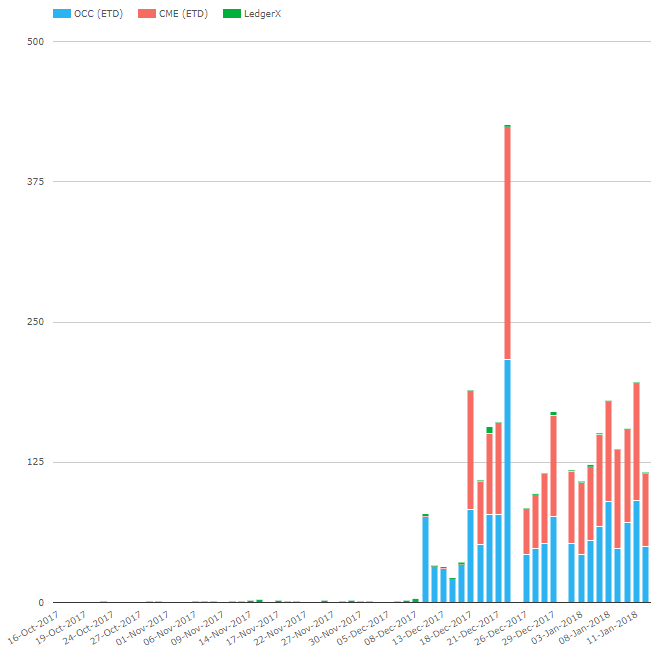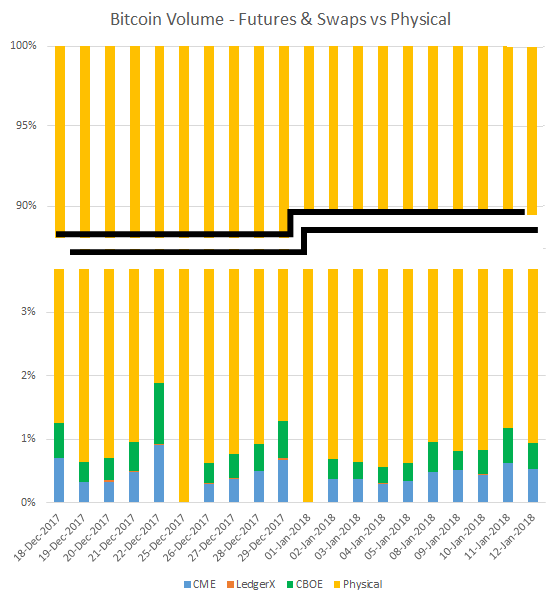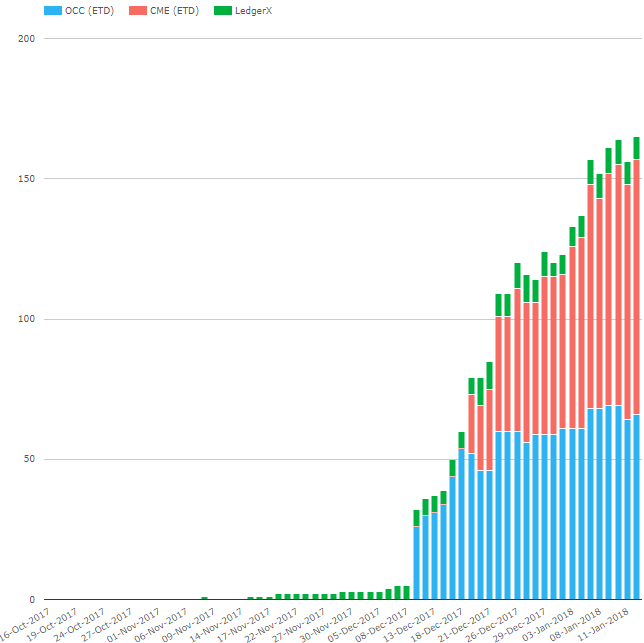It’s been an exciting time in crypto-currencies since my last couple Bitcoin articles last year. As a quick recap:
- Bitcoin Meets OTC Derivatives – Oct 24, 2017 (Bitcoin price was $5,500) – We discussed how the infrastructure for institutional investment in this space was ready. And we took a look at implied volatility of BTC options on their exchange.
- How Bitcoin Futures Will Work – Nov 15, 2017 (Bitcoin price was $7,300) – We examined what the upcoming Bitcoin futures at CBOE and CME looked like.
Since then, in the context of CFTC-regulated exchanges and clearing houses, LedgerX has transacted Bitcoin OTC forwards and options, and both CME and CBOE have launched Bitcoin futures. The price of Bitcoin touched nearly $20,000 in the US, and as of today is trading back below $10,000. And that is before we start talking about China, South Korea, Ethereum, Ripple, BCash, Dentacoin, and “flippenings”.
We at Clarus track Bitcoin volumes and open interest on regulated exchanges in our SEFView and CCPView products. I thought it would be worthwhile to document some of these numbers, and how it compares to rest of the crypto-world.
Volume Data
Starting out, let’s look at volumes of Bitcoin products at CFTC-registered Clearing Houses. This is all in terms of millions of USD equivalent volumes each day:
The data begins back in October when LedgerX launched their DCM (CFTC registered exchange) and DCO (CFTC registered clearing house). You will, however, need to look very hard to see any data (the green bars). Their largest day since inception is roughly $6 million worth of BTC. It is, however, growing, and is the only regulated US options exchange for BTC.
The first Bitcoin futures were launched December 11 at CBOE’s Futures Exchange (CFE). These products are cleared at the Options Clearing Corporation (OCC). They appear to have done over $75 million of volume on the first day, and held mostly steady with an average daily volume of about $72 million.
The next tick up is a week later when CME launched their bitcoin futures, where they did $100 million on the first day, and have kept up an ADV of roughly $82 million.
These numbers are all trounced by other financial products (swaps and futures) that we track, but they of course are starting from zero.
But how do they compare to the physical market for Bitcoin? I pulled daily volumes from CoinMarketCap, which tracks volumes across the entire crypto-universe. Looking just at Bitcoin, we can observe how CFTC regulated entities compare. Where Futures are averaging $150 million ADV, Bitcoin’s ADV is more like $15 billion.
I had a bit of trouble putting this chart together given the difference in scale, but I think you get the point. CFTC registered clearinghouses are handling, at best, under 2% of the global market.
The biggest caveat behind this is that CoinMarketCap volumes include BTC activity across all pairs. So this also includes BTC transacted against EUR, JPY, KRW, as well as other crypto-assets such as ETH, USDT, etc. However the BTCUSD pair is the largest and is consistently measured in billions of USD, whereas the futures seem to be measured in tens or couple hundreds of millions.
I don’t know how this compares to a more analogous market like gold. I tried a few quick googles. At least one academic here claims that the Gold “paper” market (futures and OTC) is 233 times larger than the physical market. And silver has a 517x ratio! Our analysis here would put Bitcoin at a 0.01x ratio.
Open Interest Data
Last I have pulled open interest. Once again, in terms of millions of USD:
This tells me that open positions are growing. But once again It is relevant to see how this compares to the “open interest” (or outstanding amount) of physical bitcoin.
So, if we take Friday’s closing Open Interest in all futures and swaps, it equates to roughly 12,500 BTC. With roughly 16.8 million BTC outstanding, this represents roughly 0.07% of the overall market.
Summary
The CFTC regulated OTC and Futures markets launched properly in Q4 2017, and have garnered immediate interest, capitalizing on the speculative frenzy that is crypto currencies. I was once told that well over 90% of futures contracts fail (citation only in my head). So Bitcoin has proven to at least be in that top 10%.
That’s it for today. We’ll keep an eye on these markets.



